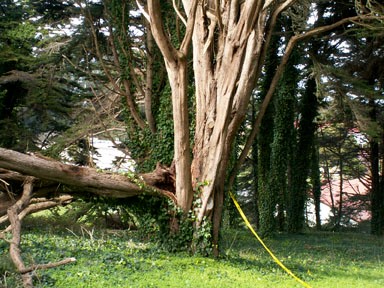Arizona cypress trees are prized for their striking pyramidal shape and soft, lacy green foliage, making them a popular choice for landscapes across the southern United States. However, these stately trees can sometimes develop stability issues, causing branches or even the entire tree to fall over. If your Arizona cypress is leaning or has toppled, don’t panic! With some detective work and proper care, you can get your tree standing upright again.
Common Causes of Falling Arizona Cypress Trees
There are several potential reasons an Arizona cypress tree may start to lean or fall over Here are some of the most common causes
-
Poor soil drainage – Arizona cypress trees prefer well-draining soil and can suffer from root rot if left in soggy conditions. Root rot damages roots and reduces their ability to anchor the tree.
-
Planting issues – Improper planting such as digging a hole too small for the root ball or planting too deeply can stunt root growth. This leads to inadequate anchoring over time.
-
Root damage – Physical injuries to roots from construction, tilling, or soil compaction hinder their functioning. Damaged roots cannot properly support the tree.
-
Pest infestations – Borers, webworms, bagworms and other pests can damage roots. Their tunnels and feeding weaken the root system.
-
Disease – Fungal diseases like root rot, as mentioned, as well as cankers or blights can make roots and other tissues decay. This deteriorates the tree’s structural integrity.
-
Extreme weather – High winds, heavy rain, ice storms and other intense weather events can topple trees with compromised root systems. Even healthy trees can be felled by powerful gusts
-
Improper pruning – Excessive pruning orincorrect branch removal eliminates anchoring branches and foliage mass crucial for stability.
-
Age – Older Arizona cypress trees naturally become more vulnerable to falling over as their trunks get heavier and internal decay weakens wood.
How to Restore an Arizona Cypress Tree to an Upright Position
If your Arizona cypress is starting to lean or has completely fallen, take action right away to get it standing straight again. Here are some tips:
-
Remove debris & loosen soil – Clear any brush or obstructions surrounding the tree. Loosen compacted soil to encourage new lateral root growth for support.
-
Prune carefully – Selectively prune branches and foliage pointing down or lowest to the ground to reduce weight pulling the tree over. Avoid over-pruning.
-
Provide stabilization – Install supportive stakes, cables or guy wires strategically around the trunk to hold the tree upright as it regrows anchoring roots.
-
Water deeply – Ensure the tree gets adequate water to nourish and stimulate root recovery. Soak soil slowly and deeply around the root zone.
-
Fertilize lightly– Apply a balanced, slow-release fertilizer to aid the tree in regaining vigor so it can put energy into righting itself. Don’t over-fertilize.
-
Monitor for pests/disease – Watch closely for signs of damaging organisms like borers which could further weaken roots and reverse progress. Take preventative and therapeutic measures as needed against threats.
-
Be patient – It may take more than one growing season for new roots to anchor the tree. Stabilize the tree and wait for roots to reestablish themselves before removing supports.
Steps to Prevent Future Falling Over
Once your Arizona cypress is upright again, you’ll want to take proactive measures to keep it that way by promoting good stability. Recommended preventive practices include:
-
Choosing a site with well-drained soil and adequate space for the mature tree.
-
Providing supplemental irrigation during drought and extreme heat. Do not overwater.
-
Top-dressing annually with compost to nourish soil biology and structure.
-
Applying micronutrients like zinc and manganese to aid root growth.
-
Aerating compacted soil around the root zone every 1-2 years.
-
Using mulch to conserve moisture and reduce weeds and grass competing for water. Don’t over-mulch.
-
Pruning judiciously in late winter to remove only necessary branches without leaving stubs.
-
Monitoring for signs of pests like borers and promptly treating infestations.
-
Managing diseases like fungal cankers by excising infected wood and using fungicides if needed.
-
Staking newly planted trees for 1-2 years until well anchored.
By pinpointing the cause of your leaning cypress and providing attentive care tailored to its needs, you can get it standing tall once again. Consistent prevention will help ensure your Arizona cypress remains upright and structurally sound season after season. Though it may take time and diligence, don’t lose hope! Just remember, a thriving, vertical tree is rooted in your careful maintenance.

k
It may look DEAD, but it’s not! Bald Cypress Trees: Are my trees dead?? (Tree: Lindsey Skyward)
FAQ
How to fix a floppy cypress tree?
Why do cypress trees fall?
Do cypress trees need a lot of water?
